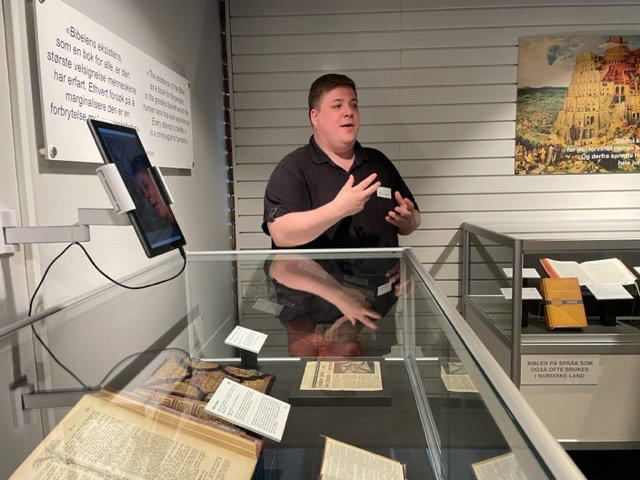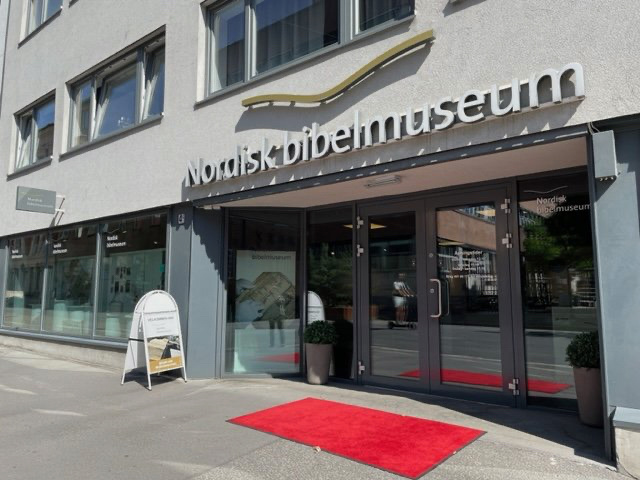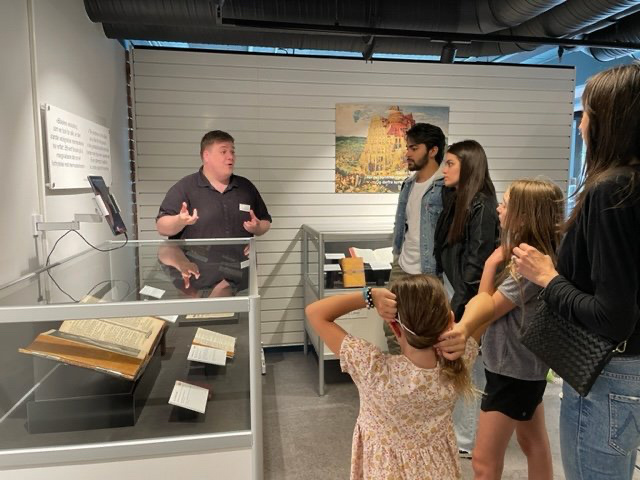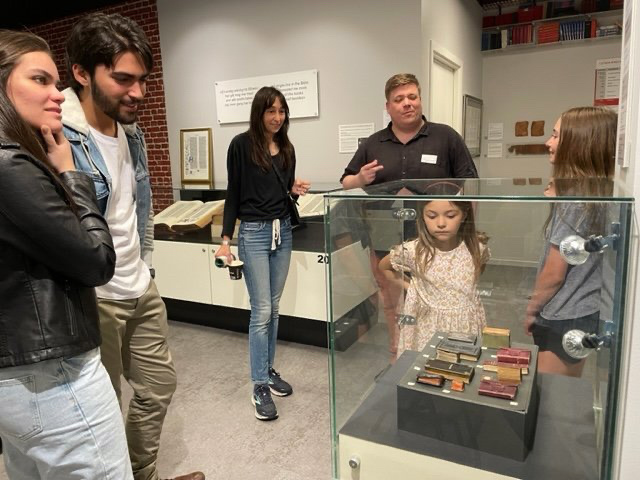
PAUL GLADER, of Religion Unplugged, visits a lesser known attraction in the Norwegian capital…
Oslo, Norway
Religion Unplugged
In the centre of this Scandinavian capital city, you’ll find a humble museum dedicated to the story of the Bible where a bartender gets to moonlight as a volunteer historian.
The Nordic Bible Museum shows up as a blip on some printed tourist maps of the downtown city centre but isn’t as well known as Oslo’s stunning Opera House or its fancy “Munch” museum dedicated to painter Edvard Munch. The Nordic Bible Museum is located near the historic Hansketorget square and in a gallery-like space on the ground floor of a residential apartment building. Yet it turns out the small museum is a useful way to understand Nordic history.

Simen Tranby gives a tour of the Nordic Bible Museum in Oslo. PICTURE: Paul Glader.
Simen Tranby welcomes me to the museum and offered to give my family a guided tour because the entire museum is in Nordic languages rather than in English. A printed guidebook in international languages is a bit daunting to use, so we gratefully accept his offer.
Tranby has a bachelor’s degree in history from the University of Oslo and manages the museum and guides on a volunteer basis. The museum and collection is owned by Rune Arnhoff, who collects Bibles. “He’s always been a collector,” Tranby says. The museum bills itself as the “only Bible museum in the Nordic countries” and also “the first virtual museum in the Nordics”.
The museum bills itself as the “only Bible museum in the Nordic countries” and also “the first virtual museum in the Nordics”.
“Rune Arnhoff is a collector by nature,” says the museum’s website. “As a child, he began collecting glossy pictures and napkins, then made coins, stamps and matchboxes. Eventually he became interested in books – and especially in the Bible.”
Over time, Arnhoff met a Norwegian shipowner named Jan Olaf Tønnevold, a longtime board member of the Norwegian Bible Society. The two men, along with other supporters, combined collections and decided to open the Nordic Bible Museum.
A journey through the museum
Tranby walks us through the exhibits, hitting the modern and odd examples first. He explains a 1662 Hebrew Bible that was, perhaps oddly, made of pigskin. He shows us a Bible in Braille that was made in Bergen, Norway, in 1995 and takes up 12 feet of shelf space. He shows us a stenographer Bible from 1890 in English that is quite succinct. He showed us student Bibles in Norwegian and an innovative “Hiker’s Bible” that’s waterproof and made of plastic. We see a “Poverty and Justice Bible” in Norwegian, which highlights “those elements” in yellow” Perhaps that’s a twist on the red-letter edition of the Bible that prints words of Jesus in red type.
Most touching to me is when he shows us a Norwegian Bible for people with dementia that features more pictures and a stronger binding so “if they have an episode, they don’t tear it to pieces.” Leave it to the Norwegians to create a Bible with that much thought, empathy and innovation!
Throughout the museum, I see quotes from historical figures such as Teddy Roosevelt and Immanuel Kant, who articulated the importance and influence of the Bible. For example, a Ronald Reagan quote reads, “Within the covers of the Bible are answers for all the problems men face.”
An odd country for a Bible museum?
At one point, Tranby notes that “Norway is a fairly non-religious country” with only two per cent of people actively attending church, while nearly everyone goes through confirmation. Even still, 25 per cent of Norwegians now identify as non-religious, and some secular Norwegians can recite humanist views at a secular version of confirmation. I’m intrigued by these data points.
A report from the US State Department notes that roughly 68 per cent of the 5.5 million people in Norway belong to the Church of Norway in 2020, which is an evangelical Lutheran denomination. That’s a decline of 2.8 percentage points from 2017. Other Christian denominations and religions make up 12.6 per cent of the population as of 2021.
The Association of Religion Data Archives confirms that while a majority of Norwegians identify as Christian and belong to the state church, few Norwegians attend church regularly. And over time, Christianity is declining in Norway as other faiths are slowly increasing from a low base. The chart below from ARDA predicts Protestants to represent 63.5 per cent of Norway’s population by 2050 and Sunni Islam to represent 11.7 per cent by that time.
“Why do you think so few people go to church actively here now?” I ask Tranby.
“A lot of it rests on Protestantism,” Tranby says. “The idea that ‘Well, God is everywhere! Why should we have to go to church?’”
He thinks for a moment, then continues.
“I do think people view themselves as spiritual in some way if not necessarily Christian.” It used to be that church was the place to go to be spiritual and feel spiritual.

Entrance of the Nordic Bible Museum in Oslo. PICTURE: Paul Glader.
The story of Scandinavia via the Bible
We then continue with the tour, looking at Bibelen in Danish, Biblia in Greenlandish and Bibeln in Swedish. And we start getting into the history of the Bible and its translation into the Nordic languages, learning how the Bible intersected with culture, politics, conflicts, geography and strategy over the centuries in Scandinavia. I realize the history of the Nordic Bible is also a great lens into the history of the Nordic people.
We hear about Nordic phrases that come from the Bible, such as “Wolf in sheep’s clothing” (ulv i fåreklær). We see Bibles commissioned by leaders of Sweden and other Nordic countries, sometimes lost in battle. One Danish royal family, starting with King Christian III, kept printing a king’s edition with larger binding and more flourishing touches as each new king tried to outdo his father in Oedipal fashion with a more ornate personal edition of the Bible. It was the era in which a Bible carried the weight of a King James in an equivalent way perhaps that a Nike shoe carried the brand and legacy of a celebrity like Michael Jordan.
Norway didn’t get its own translation of the New Testament until 1819 and a full Bible in 1829. Its early Bibles were modest, in dark leather and without the ornate treatments of the kingly Swedish and Danish Bibles. Tranby says this is partly because Norway bounced between Denmark, Sweden and other overlords.
“Norway was so dirt poor initially,” Tranby says. “Norway used to be the poorest country in Europe, comparable to Ireland and countries in Africa.” That all changed during the industrial revolution and, particularly, when Norway found oil in the 1970s on its coast, creating a massively wealthy country.
We rely on our readers to fund Sight's work - become a financial supporter today!
For more information, head to our Subscriber's page.
When the Christian conservative political party was in office during the 1994 Lillehammer Winter Olympics, Norway printed New Testament Bibles in three languages and gave them to all participants in the games.
With its Christian roots, Norwegians have translated the Bible into the languages of the Indigenous Sami people in the far north of the Nordic region. Tranby notes the first Sami Bibles are “super, super rare,” with only eight or so copies remaining of 100 printed editions. This museum has two of the eight remaining copies. “There has to be more,” he said.
Why so few of those copies remain?
The Sami “lived in tents,” he said. “It was wet.”
“They needed the hiker’s Bible,” my wife quipped, referring to the earlier modern Bible we saw.
We start seeing some more interesting and odd editions of the Bible. One Danish couple named Anna Sophie and Paul Sidelin made a translation in 1974 focused on making the language “sound beautiful.”
A Greenland edition of the Bible used super long words and had to adapt some wording for local culture. For example, people in Greenland didn’t grow grain or eat bread. So the passage, “Give us our daily bread” in the Lord’s prayer didn’t make sense to them. So the translators wrote “Give us our daily seals.”

Simen Tranby gives a tour of the Nordic Bible Museum in Oslo. PICTURE: Paul Glader.
Tiny Bibles fit for Barbie
One of the showstopper displays at the museum features a set of super tiny Bibles as small as matchboxes that printers used to “show off that you can print that small” in the 1800s.
“It looks like it’s for my Barbies!” my daughter says.
Tranby notes that those Bibles might come with lenses to read the words.
After that levity, we hit a somber note as we learn about Bibles in continental Europe that earned death for reformers like William Tyndale. “Being a Bible translator was one of the most dangerous jobs in Europe because of the risk of being burned as a heretic,” Tranby said.
The museum is not the most interactive for kids, although they have one display where kids or adults can don a cloak and use feather ink pens to see how a translator might have written on early forms of paper. And visitors can see and touch a few artifacts with help from a guide.
Before the tour is over, we see an original page from a Gutenberg Bible from the 1400s, the only one on display in Norway. We see Bibles illustrated by Rembrandt, Gustave Dore and Salvadore Dali. As we wrap up the tour, my wife asks Tranby and another guide what they think about printed books versus digital books.
“I see no problem in having printed books if you can afford them,” he says. “It gives you an opportunity to mark a book in ways you can’t with online books.” But then, in careful Norwegian fashion, he demurs so as not to offend anyone who might object. “There is no shame in using an electronic book. It’s good to read many kinds of books.”
The entire space is neat, clean with orderly display cases, well-designed placards and polished concrete floors. The gift shop sells beautiful replicas of a 1769 Swedish family Bible for 1,396 Norwegian crowns, a Geneva Bible replica from 1560 for 1,180 crowns and a 1611 King James Version of the Bible for 1,180 crowns. Plus it sells quills, ink vats and plenty of modern copies of the Bible in Nordic languages.

People on a tour with Simen Tranby of the Nordic Bible Museum in Oslo. PICTURE: Paul Glader.
Forging ahead
Tranby notes the museum has a collection of 4,000 Bibles and decided to open this museum in 2018, which wasn’t the easiest date to launch.
“It’s a little bit rocky,” he says, noting that the pandemic years in 2020-2022 “were difficult.”
Does this museum have any connection to that big Museum of the Bible in Washington, DC, that was started by the billionaire Green family that owns the Hobby Lobby franchise in America?
“We have a cordial relationship to the museum in DC but no official affiliation. This is his personal collection.” Tranby notes the Nordic museum receives no government subsidies and is run by volunteers like Tranby, who works at the museum two to three days per week.
“Why do you volunteer?” I ask.
“Well, because I am a historian and I like the Bible,” Tranby says. “It’s a fascinating history.”
He says it’s a fun place to work but you “need to have employment on the side” to be able to pay rent and live in Oslo.
“So what do you do on the side?”
“I’m a bartender!”
We laugh and my family prepares to leave, as we’ve already stayed past closing time. My wife asks if we can give a tip to Tranby and the volunteers in thanks for their excellent tour and their excellent museum. He declines, saying they don’t accept tips.
At a bar, yes. At the Nordic Bible Museum, no.






